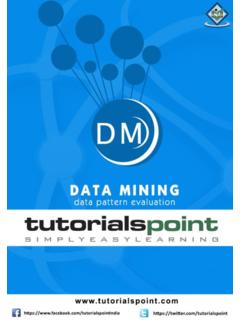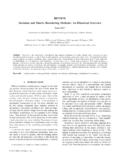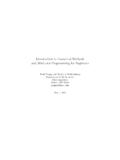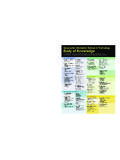Transcription of Neural Discrete Representation Learning - arXiv
1 Neural Discrete Representation LearningAaron van den useful representations without supervision remains a key challenge inmachine Learning . In this paper, we propose a simple yet powerful generativemodel that learns such Discrete representations. Our model, the Vector Quantised-Variational AutoEncoder (VQ-VAE), differs from VAEs in two key ways: theencoder network outputs Discrete , rather than continuous, codes; and the prioris learnt rather than static. In order to learn a Discrete latent Representation , weincorporate ideas from vector quantisation (VQ). Using the VQ method allows themodel to circumvent issues of posterior collapse - where the latents are ignoredwhen they are paired with a powerful autoregressive decoder - typically observedin the VAE framework.
2 Pairing these representations with an autoregressive prior,the model can generate high quality images, videos, and speech as well as doinghigh quality speaker conversion and unsupervised Learning of phonemes, providingfurther evidence of the utility of the learnt IntroductionRecent advances in generative modelling of images [38,12,13,22,10], audio [37,26] and videos[20,11] have yielded impressive samples and applications [24,18]. At the same time, challengingtasks such as few-shot Learning [34], domain adaptation [17], or reinforcement Learning [35] heavilyrely on learnt representations from raw data, but the usefulness of generic representations trained inan unsupervised fashion is still far from being the dominant likelihood and reconstruction error are two common objectives used to train unsupervisedmodels in the pixel domain, however their usefulness depends on the particular application thefeatures are used in.
3 Our goal is to achieve a model that conserves the important features of thedata in its latent space while optimising for maximum likelihood. As the work in [7] suggests, thebest generative models (as measured by log-likelihood) will be those without latents but a powerfuldecoder (such as PixelCNN). However, in this paper, we argue for Learning Discrete and useful latentvariables, which we demonstrate on a variety of representations with continuous features have been the focus of many previous work[16,39,6,9] however we concentrate on Discrete representations [27,33,8,28] which are potentiallya more natural fit for many of the modalities we are interested in.
4 Language is inherently Discrete ,similarly speech is typically represented as a sequence of symbols. Images can often be describedconcisely by language [40]. Furthermore, Discrete representations are a natural fit for complexreasoning, planning and predictive Learning ( , if it rains, I will use an umbrella). While usingdiscrete latent variables in deep Learning has proven challenging, powerful autoregressive modelshave been developed for modelling distributions over Discrete variables [37].In our work, we introduce a new family of generative models succesfully combining the variationalautoencoder (VAE) framework with Discrete latent representations through a novel parameterisationof the posterior distribution of ( Discrete ) latents given an observation.
5 Our model, which relies onvector quantization (VQ), is simple to train, does not suffer from large variance, and avoids the31st Conference on Neural Information Processing Systems (NIPS 2017), Long Beach, CA, [ ] 30 May 2018 posterior collapse issue which has been problematic with many VAE models that have a powerfuldecoder, often caused by latents being ignored. Additionally, it is the first Discrete latent VAE modelthat get similar performance as its continuous counterparts, while offering the flexibility of discretedistributions. We term our model the VQ-VAE can make effective use of the latent space, it can successfully model importantfeatures that usually span many dimensions in data space (for example objects span many pixels inimages, phonemes in speech, the message in a text fragment, etc.)
6 As opposed to focusing or spendingcapacity on noise and imperceptible details which are often , once a good Discrete latent structure of a modality is discovered by the VQ-VAE, we traina powerful prior over these Discrete random variables, yielding interesting samples and usefulapplications. For instance, when trained on speech we discover the latent structure of languagewithout any supervision or prior knowledge about phonemes or words. Furthermore, we can equipour decoder with the speaker identity, which allows for speaker conversion, , transferring thevoice from one speaker to another without changing the contents.
7 We also show promising results onlearning long term structure of environments for contributions can thus be summarised as: Introducing the VQ-VAE model, which is simple, uses Discrete latents, does not suffer from posterior collapse and has no variance issues. We show that a Discrete latent model (VQ-VAE) perform as well as its continuous modelcounterparts in log-likelihood. When paired with a powerful prior, our samples are coherent and high quality on a widevariety of applications such as speech and video generation. We show evidence of Learning language through raw speech, without any supervision, andshow applications of unsupervised speaker Related WorkIn this work we present a new way of training variational autoencoders [23,32] with Discrete latentvariables [27].
8 Using Discrete variables in deep Learning has proven challenging, as suggested bythe dominance of continuous latent variables in most of current work even when the underlyingmodality is inherently exist many alternatives for training Discrete VAEs. The NVIL [27] estimator use a single-sampleobjective to optimise the variational lower bound, and uses various variance-reduction techniques tospeed up training. VIMCO [28] optimises a multi-sample objective [5], which speeds up convergencefurther by using multiple samples from the inference a few authors have suggested the use of a new continuous reparemetrisation based on theso-called Concrete [25] or Gumbel-softmax [19] distribution, which is a continuous distribution andhas a temperature constant that can be annealed during training to converge to a Discrete distributionin the limit.
9 In the beginning of training the variance of the gradients is low but biased, and towardsthe end of training the variance becomes high but of the above methods, however, close the performance gap of VAEs with continuous latentvariables where one can use the Gaussian reparameterisation trick which benefits from much lowervariance in the gradients. Furthermore, most of these techniques are typically evaluated on relativelysmall datasets such as MNIST, and the dimensionality of the latent distributions is small ( , below8). In our work, we use three complex image datasets (CIFAR10, ImageNet, and DeepMind Lab) anda raw speech dataset (VCTK).
10 Our work also extends the line of research where autoregressive distributions are used in the decoderof VAEs and/or in the prior [14]. This has been done for language modelling with LSTM decoders [4],and more recently with dilated convolutional decoders [42]. PixelCNNs [29,38] are convolutionalautoregressive models which have also been used as distribution in the decoder of VAEs [15, 7].Finally, our approach also relates to work in image compression with Neural networks. Theis et. al.[36] use scalar quantisation to compress activations for lossy image compression before arithmeticencoding. Other authors [1] propose a method for similar compression model with vector authors propose a continuous relaxation of vector quantisation which is annealed over timeto obtain a hard clustering.
![arXiv:0706.3639v1 [cs.AI] 25 Jun 2007](/cache/preview/4/1/3/9/3/1/4/b/thumb-4139314b93ef86b7b4c2d05ebcc88e46.jpg)

![arXiv:1301.3781v3 [cs.CL] 7 Sep 2013](/cache/preview/4/d/5/0/4/3/4/0/thumb-4d504340120163c0bdf3f4678d8d217f.jpg)
![@google.com arXiv:1609.03499v2 [cs.SD] 19 Sep 2016](/cache/preview/c/3/4/9/4/6/9/b/thumb-c349469b499107d21e221f2ac908f8b2.jpg)












